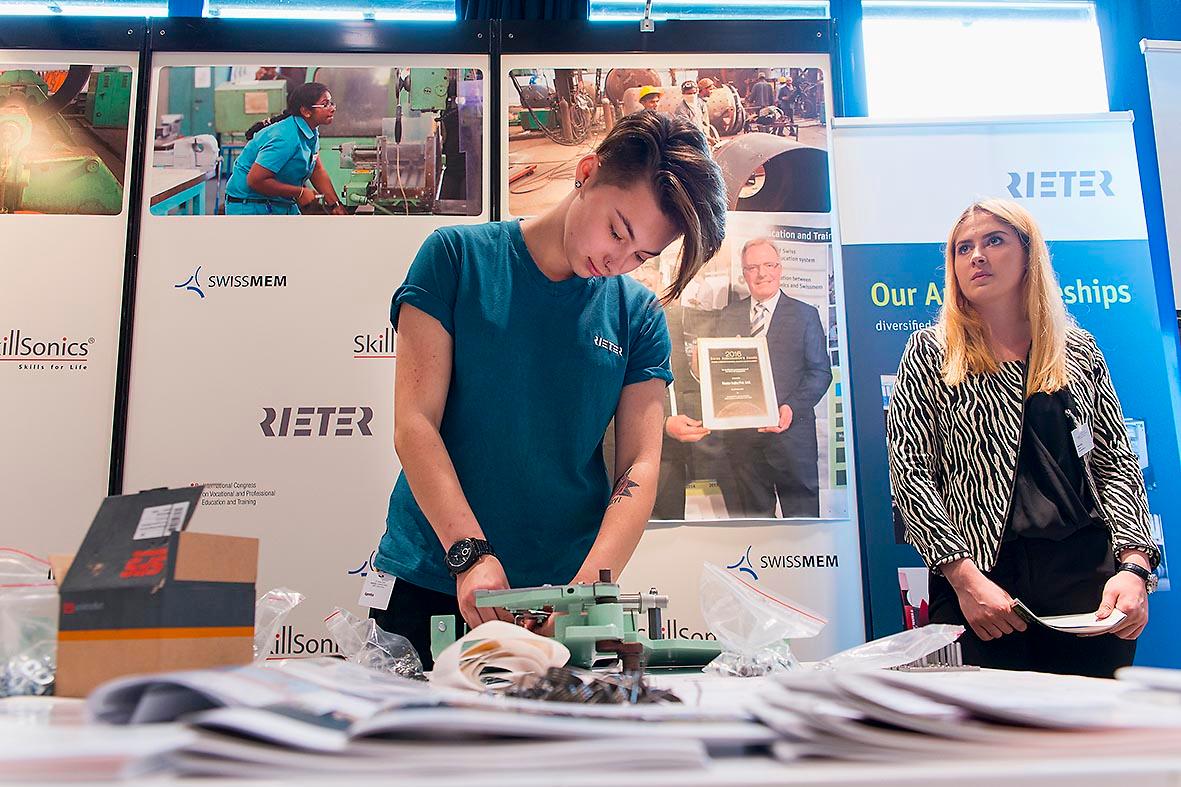Asian nations want industry and youth to embrace vocational training

With a median population under the age of 30 and high unemployment rates, Asian countries are looking to vocational education to prevent their demographic dividend from becoming a curse.
It is 10am and the entrance area at the Winterthur Theatre is abuzz with people. They are not here to watch a play but to take part in the 3rd International Conference on Vocational and Professional Education and TrainingExternal link (VPET) hosted by Switzerland. Coming from countries as far away as Indonesia and Tanzania, they are keen to see how the Swiss apprenticeship model can be adapted to their countries.
“We apply the dual education system that was brought by Jesuits from Switzerland in 1968,” explains Wahyo Nursanto, the operational director at vocational institute ATMI-APII Indonesia.
“The core focus is industrial activities with two-thirds in the form practical workshop training and the remaining third in the classroom,” adds the Indonesian native who stood out from the dark suited crowd with his batik print shirt.
Nursanto’s school churns out around 200 apprentices a year who have around a thousand posts in various companies to choose from. “The demand is very high especially from the automotive, food and automation companies, Swiss and European ones,” he tells swissinfo.ch.
Despite the strong need for trained technicians, companies in Indonesia, where the median age is 28, have not really invested in training future employees. But attitudes are slowly shifting. Last year, the first association for polytechnics and industry was established.
The Indonesian association was inspired in part by Swissmem: the umbrella association of Swiss engineering firms that has invested heavily in Swiss vocational education. Indonesia’s government has also shown an interest in promoting industry partnerships in vocational education and training (VET) in recent years.
“Companies in Indonesia are looking for competent employees but not all graduates can match their needs. That is why the government is pushing the schools and the industry to cooperate and obtain enough competent industrial workers,” says Pramono Setyoko, managing director at the ministry of industry.
One country that needs a lot of competent technicians is India, where half of a population exceeding 1.2 billion is under the age of 25. Currently, only 5% of the workforce has been formally skilled through vocational institutes. Estimates suggest the country will need more than 100 million technicians by 2020, and that’s without upgrading the skills of the existing workforce..
“Skilling is a space we ignored since independence in 1947, says Jayant Krishna, executive director of the National Skill Development Corporation. “We became serious barely 10 years ago when the funding level and seriousness increased.”
Funding was obtained from private companies via a law on corporate social responsibility that obliges firms to dedicate 2% of net profit to worthy causes. The money helped finance several VET schemes including one that provides free training — lasting between 200 to 500 hours – to two million disadvantaged youth annually.
Laos, with a median age of 23, is also trying to upgrade its vocational education system. The country currently offers five levels of VET, ranging from a first certificate to a higher diploma. But companies still struggle to find the right people for the job, according to Vannalek Luang of the Laos ministry of education and sport.
”The big obstacle is a lack of facilities, equipment and qualified teachers,” he says. “Lack of qualified technicians is a problem and companies want to cooperate with the public sector to train young people.”
Laos, he adds, is working with donors to upgrade the skills of vocational teachers. One such programme that focuses on hospitality training is co-financed by Switzerland and Luxembourg. But VET doesn’t seem to have too much buy in from the student population for now.
“Our government tries to encourage youth to enroll in VET but in the last few years more want to go to university,” says Luang from Laos.
A new entrant to the VET scene is Myanmar. With a median age of 27 and 55% of its population under the age of 30, the South Asian nation is trying to overhaul its education system and develop a vocational training system from scratch.
“With support of NGOs and international organisations we are introducing VET in activities like beautician, tailor, cabinet maker, electrician in rural areas and hospitality in urban areas,” says Cho Cho Mar, head of a hospitality training at Swisscontact Myanmar. “We do not want to copy and paste because we have to see how the European model fits in with our country.”
University attraction
On the other end of the Asian spectrum is Singapore with its well-established VET system. Students there can get their first certificate after a three-year course from the Institute for Technical Education. They can then pursue further studies at a polytechnic or start working immediately.
But like their peers in most Asian nations, the students of Singapore prefer to go to university.
“The ones who opt for vocational education are those that are not academically inclined or have a passion for certain areas of interest.,” says David Chai, director of Singapore Polytechnic Centre. “There is still this emphasis on going the university degree route but there is increasing recognition of vocational education pathways.”
One of the ways the government is promoting VET as a choice among youngsters is through a national campaign called Skills Future. It promotes the concept of mastering a craft. There is also a push to look at a career as dynamic rather than static, along with an emphasis on lifelong learning.
“Vocational education allows you to go deeper in the areas you are interested in,” says Chai.
Like Singapore, Indonesia is also touting the merits of the VET system to its youth. Currently, the number of Indonesian students opting for the vocational path is not widely different from those angling for a more general education.
“We managed to convince the youth that vocational education can lead to a good career and that there is no need to chase a university degree.” says Setyoko of the Indonesian industry ministry. “There is no point in having a degree if you don’t have a job.”

In compliance with the JTI standards
More: SWI swissinfo.ch certified by the Journalism Trust Initiative





You can find an overview of ongoing debates with our journalists here. Please join us!
If you want to start a conversation about a topic raised in this article or want to report factual errors, email us at english@swissinfo.ch.